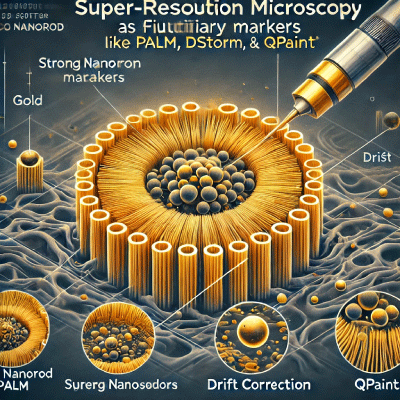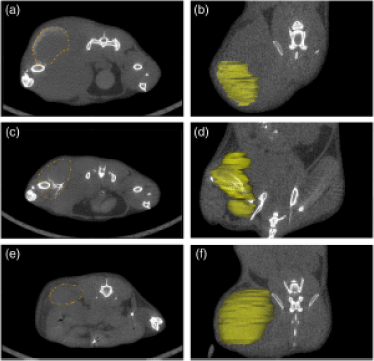Gold Nanorods as Fiduciary Markers for Super-Resolution Microscopy: PALM, dSTORM, qPAINT, and More
Gold nanorods (AuNRs) are widely recognized for their exceptional optical properties, making them indispensable in super-resolution microscopy techniques like PALM, dSTORM, and qPAINT. At Nanopartz, we provide precisely engineered gold nanorods tailored for use as fiduciary markers in these advanced imaging systems. Their unique ability to scatter light, combined with chemical stability and resistance to photobleaching, makes them the ideal choice for high-precision spatial alignment and drift correction in nanoscale imaging.
Image illustrating how gold nanorods are used as fiduciary markers in super-resolution microscopy techniques like PALM, dSTORM, and qPAINT. The image highlights the drift correction and strong scattering properties of the gold nanorods. |
|---|
Properties of Nanopartz Gold Nanorods as Fiduciary Markers
- Localized Surface Plasmon Resonance (LSPR): Gold nanorods exhibit strong LSPR, allowing them to scatter light efficiently and be easily detected under various microscopy techniques.
- Shape Anisotropy: Their rod-like shape offers distinct optical properties based on their orientation, providing additional data points in imaging systems.
- Photostability: Unlike fluorescent dyes, gold nanorods do not suffer from photobleaching, making them ideal for long-term imaging sessions.
- Size Customization: Nanopartz offers a wide range of sizes (10 nm - 50 nm) and surface functionalizations to meet specific research needs, including PEGylation and antibody conjugation.
- High Contrast: The strong scattering signal of gold nanorods makes them stand out as fiduciary markers, providing a fixed reference point in dynamic biological samples.
Applications in Super-Resolution Microscopy
Gold nanorods serve as fiduciary markers across multiple super-resolution microscopy techniques, ensuring high spatial accuracy and precise localization. They are essential in:
- PALM (Photoactivated Localization Microscopy): Gold nanorods are used to correct for drift and spatial distortions in PALM, providing accurate alignment across multiple imaging cycles.
- dSTORM (Direct Stochastic Optical Reconstruction Microscopy): In dSTORM, gold nanorods act as stable fiduciary markers to anchor the spatial orientation of fluorescent molecules, which blink on and off during the imaging process.
- qPAINT (quantitative Point Accumulation for Imaging in Nanoscale Topography): Gold nanorods improve the spatial accuracy of qPAINT by providing non-bleaching reference points, enhancing the quantification of molecular interactions.
These techniques benefit from the high stability and bright scattering signal of Nanopartz gold nanorods, ensuring reliable imaging and data accuracy in nanoscale investigations.
How Gold Nanorods Work as Fiduciary Markers
Gold nanorods function as fiduciary markers by serving as fixed reference points that do not photobleach or degrade over time. In super-resolution microscopy, the following steps describe their role:
-
Drift Correction: Biological samples tend to move slightly during imaging. Gold nanorods are integrated into the sample to act as stationary markers, providing fixed coordinates. This enables researchers to track and correct any drift that occurs during data acquisition.
-
Orientation and Spatial Alignment: The anisotropy of gold nanorods allows researchers to determine the orientation of the sample. Their bright scattering signal ensures that they remain visible across multiple imaging rounds, making them invaluable for aligning sequential images with high precision.
-
Quantitative Analysis: In methods like qPAINT, the stability and visibility of gold nanorods improve the accuracy of molecular binding measurements by ensuring that the localization data remains consistent throughout the imaging process.
Advantages of Nanopartz Gold Nanorods as Fiduciary Markers
- High Photostability: Gold nanorods resist photobleaching, unlike conventional fluorescent dyes, making them ideal for extended imaging sessions.
- Bright Scattering Signal: Their enhanced LSPR provides a strong signal, making them easy to detect even in complex biological environments.
- Biocompatibility: Nanopartz gold nanorods are biocompatible, ensuring they do not interfere with biological processes, and can be customized with bioconjugates for specific targeting.
- Precision: Their well-defined shape and optical properties allow for high-precision spatial correction, crucial for super-resolution techniques.
Workflow for Using Gold Nanorods in Super-Resolution Microscopy
-
Sample Preparation: Gold nanorods are introduced into the sample. In biological samples, they can be conjugated to antibodies or other targeting molecules to ensure they remain fixed in place.
-
Imaging: During super-resolution microscopy, the gold nanorods scatter light and appear as bright spots, which serve as reference points. Their consistent presence helps anchor the sample and correct any mechanical drift or alignment errors.
-
Data Collection and Analysis: The stable position of gold nanorods is used to align sequential images and improve localization precision. This enhances the accuracy of the resulting super-resolution images, especially in techniques like PALM, dSTORM, and qPAINT.
-
Drift Correction and Quantification: In techniques like qPAINT, gold nanorods provide a fixed reference for drift correction, ensuring that quantitative measurements of molecular interactions are reliable and reproducible.
References
-
ZEISS ELYRA Sample Preparation for Superresolution Microscopy – a Quick Guide. Available at: elyra_sample-prep-quickguide.
This guide covers the principles of sample preparation for super-resolution microscopy, including how fiduciary markers like gold nanorods are used for alignment and drift correction. -
Huang, B., Bates, M., & Zhuang, X. (2008). Super-Resolution Fluorescence Microscopy. Annual Review of Biochemistry, 78, 993-1016.
Discusses the development and application of super-resolution microscopy techniques such as PALM and dSTORM, and the importance of fiduciary markers like gold nanorods. -
Shtaya, A. et al. (2020). Super-Resolution Imaging in Cell Biology. Methods in Molecular Biology, 2111, 3-19.
Explores super-resolution techniques like PALM and qPAINT, emphasizing the need for stable fiduciary markers for accurate drift correction. -
Nanopartz. (2024). Gold Nanorods for High Precision Microscopy Applications. Available at: https://www.nanopartz.com.
Provides detailed product information on Nanopartz gold nanorods, including their use in microscopy applications -
Wang et al. (2021) Reactive Oxygen FIB spin milling enables correlative workflow for 3D super-resolution light microscopy and serial FIB/SEM of cultured cells, https://www.nature.com/articles/s41598-021-92608-y. Discusses use of Nanopartz gold nanorods as gold fiduciaries.
- Baker et al. (2019) Stoichiometric quantification of spatially dense assemblies with qPAINT, https://www.biorxiv.org/content/biorxiv/early/2019/01/21/525345.full.pdf, Nanopartz gold Nanorods as qpaint fiduciaries.
Summary
Gold nanorods are revolutionizing super-resolution microscopy techniques such as PALM, dSTORM, and qPAINT by serving as highly reliable fiduciary markers. Their unique optical properties, including localized surface plasmon resonance (LSPR) and shape anisotropy, make them ideal for precise drift correction and spatial alignment. Unlike traditional fluorescent dyes, gold nanorods do not photobleach, ensuring long-term stability in imaging sessions. Their ability to enhance the accuracy of nanoscale imaging makes them indispensable in biological and material science research.
Nanopartz gold nanorods are specially designed for use in super-resolution microscopy, offering customization options in terms of size, functionalization, and surface chemistry. By integrating these high-performance nanorods into your imaging workflow, researchers can achieve superior quantitative imaging, molecular tracking, and nanoscale structural analysis.
Key Benefits:
- Photostability for long-term imaging.
- High contrast and scattering efficiency.
- Versatile applications in PALM, dSTORM, qPAINT, and other microscopy techniques.
- Precision drift correction and spatial accuracy.
Go here to purchase Nanopartz Gold Nanoparticles for super resolution microscopy applications


